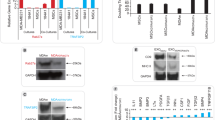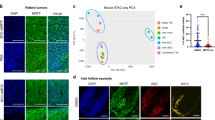Abstract
Basal cell carcinoma (BCC) is the most frequent cancer in the Caucasian population. Cells of BCC strongly express Fas-ligand (FasL), a member of the tumor necrosis family, which induces apoptosis in Fas receptor-expressing cells. It has been suggested that by expression of FasL, BCC cells may evade the attack of Fas-positive immune effector cells allowing the tumor to expand. Thus, downregulation of FasL should prime BCC to the assault of immune effector cells. Recently, it has been shown that RNA interference is a highly successful approach to specifically silence a gene of interest in single cells and some animal models. However, RNAi in human tissues has not been shown so far. Here, we provide evidence that small interfering RNAs (siRNAs) efficiently transfect tumor tissue ex vivo and silence the gene of interest. We demonstrate that a specific siRNA efficiently downregulates FasL not only in FasL-positive indicator cells but also in surgically excised BCC tissue at both the protein and the mRNA level. The successful transfection of tumor tissues with siRNAs now allows to test the function of the molecule under study and opens up the investigation of other target genes in the tumor.
This is a preview of subscription content, access via your institution
Access options
Subscribe to this journal
Receive 12 print issues and online access
$259.00 per year
only $21.58 per issue
Buy this article
- Purchase on Springer Link
- Instant access to full article PDF
Prices may be subject to local taxes which are calculated during checkout





Similar content being viewed by others
References
Buechner SA et al. Regression of basal cell carcinoma by intralesional interferon-alpha treatment is mediated by CD95 (Apo-1/Fas)-CD95 ligand-induced suicide. J Clin Invest 1997; 100: 2691–2696.
Lee SH et al. Fas ligand is expressed in normal skin and in some cutaneous malignancies. Br J Dermatol 1998; 139: 186–191.
GutierrezSteil C et al. Sunlight-induced basal cell carcinoma tumor cells and ultraviolet-B-irradiated psoriatic plaques express Fas ligand (CD95L). J Clin Invest 1998; 101: 33–39.
Jang TJ . Expression of CD40 and Fas ligand in Bowen's disease, squamous cell carcinoma and basal cell carcinoma. Yonsei Med J 2002; 43: 304–308.
Hahne M et al. Melanoma cell expression of Fas(Apo-1/CD95) ligand: implications for tumor immune escape. Science 1996; 274: 1363–1366.
Igney FH, Behrens CK, Krammer PH . Tumor counterattack – concept and reality. Eur J Immunol 2000; 30: 725–731.
Nyhus JK, Wolford C, Feng L, BarberaGuillem E . Direct in vivo transfection of antisense Fas-ligand reduces tumor growth and invasion. Gene Therapy 2001; 8: 209–214.
Ji JM, Wernli M, Buechner S, Erb P . Fas ligand downregulation with antisense oligonucleotides in cells and in cultured tissues of normal skin epidermis and basal cell carcinoma. J Invest Dermatol 2003; 120: 1094–1099.
Elbashir SM et al. Duplexes of 21-nucleotide RNAs mediate RNA interference in cultured mammalian cells. Nature 2001; 411: 494–498.
Elbashir SM, Lendeckel W, Tuschl T . RNA interference is mediated by 21- and 22-nucleotide RNAs. Genes Dev 2001; 15: 188–200.
Coburn GA, Cullen BR . Potent and specific inhibition of human immunodeficiency virus type 1 replication by RNA interference. J Virol 2002; 76: 9225–9231.
Jacque JM, Triques K, Stevenson M . Modulation of HIV-1 replication by RNA interference. Nature 2002; 418: 435–438.
Novina CD et al. siRNA-directed inhibition of HIV-1 infection. Nat Med 2002; 8: 681–686.
Gitlin L, Karelsky S, Andino R . Short interfering RNA confers intracellular antiviral immunity in human cells. Nature 2002; 418: 430–434.
Park WS, Hayafune M, MiyanoKurosaki N, Takaku H . Specific HIV-1 env gene silencing by small interfering RNAs in human peripheral blood mononuclear cells. Gene Therapy 2003; 10: 2046–2050.
Randall G, Grakoui A, Rice CM . Clearance of replicating hepatitis C virus replicon RNAs in cell culture by small interfering RNAs. Proc Nat Acad Sci USA 2003; 100: 235–240.
Hamasaki K et al. Short interfering RNA-directed inhibition of hepatitis B virus replication. FEBS Lett 2003; 543: 51–54.
Jiang M, Milner J . Selective silencing of viral gene expression in HPV-positive human cervical carcinoma cells treated with siRNA, a primer of RNA interference. Oncogene 2002; 21: 6041–6048.
Jia QM, Sun R . Inhibition of gammaherpesvirus replication by RNA interference. J Virol 2003; 77: 3301–3306.
Song EW et al. RNA interference targeting Fas protects mice from fulminant hepatitis. Nat Med 2003; 9: 347–351.
Rubinson DA et al. A lentivirus-based system to functionally silence genes in primary mammalian cells, stem cells and transgenic mice by RNA interference. Nat Genet 2003; 33: 401–406.
Martinez MA et al. Suppression of chemokine receptor expression by RNA interference allows for inhibition of HIV-1 replication. AIDS 2002; 16: 2385–2390.
Brummelkamp TR, Bernards R, Agami R . Stable suppression of tumorigenicity by virus-mediated RNA interference. Cancer Cell 2002; 2: 243–247.
Scherr M et al. Specific inhibition of bcr-abl gene expression by small interfering RNA. Blood 2003; 101: 1566–1569.
Hutvagner G, Simard MJ, Mello CC, Zamore PD . Sequence-specific inhibition of small RNA function. PLoS Biol 2004; 2: 465–475.
Aoki Y et al. RNA interference may be more potent than antisense RNA in human cancer cell lines. Clin Exp Pharmacol Physiol 2003; 30: 96–102.
Dykxhoorn DM, Novina CD, Sharp PA . Killing the messenger: short rnas that silence gene expression. Nat Rev Mol Cell Biol 2003; 4: 457–467.
Pickford AS, Cogoni C . RNA-mediated gene silencing. Cell Mol Life Sci 2003; 60: 871–882.
Agrawal N et al. RNA interference: biology, mechanism, and applications. Microbiol Mol Biol Rev 2003; 67: 657.
Hasuwa H, Kaseda K, Einarsdottir T, Okabe M . Small interfering RNA and gene silencing in transgenic mice and rats. FEBS Lett 2002; 532: 227–230.
McCaffrey AP et al. Gene expression – RNA interference in adult mice. Nature 2002; 418: 38–39.
Sorensen DR, Leirdal M, Sioud M . Gene silencing by systemic delivery of synthetic siRNAs in adult mice. J Mol Biol 2003; 327: 761–766.
McCaffrey AP et al. Inhibition of hepatitis B virus in mice by RNA interference. Nat Biotechnol 2003; 21: 639–644.
Hull D, Timmons L . Methods for delivery of double-stranded RNA into Caenorhabditis elegans. Methods Mol Biol 2004; 265: 23–58.
Filleur S et al. SiRNA-mediated inhibition of vascular endothelial growth factor severely limits tumor resistance to antiangiogenic thrombospondin-1 and slows tumor vascularization and growth. Cancer Res 2003; 63: 3919–3922.
Calegari F et al. Tissue-specific RNA interference in postimplantation mouse embryos with endoribonuclease-prepared short interfering RNA. Proc Natl Acad Sci USA 2002; 99: 14236–14240. Epub 2002 Oct 21.
Bachmann F et al. Ultraviolet light downregulates CD95 ligand and trail receptor expression facilitating actinic keratosis and squamous cell carcinoma formation. J Invest Dermatol 2001; 117: 59–66.
Acknowledgements
We thank U Guenthert, E Kump, Andrea Glaser and J Samaridis for discussion and critical reading of the manuscript, and M Colombi for technical assistance. This study was supported by Swiss National Science Funds Grant-nr. 3100AO-064233.00.
Author information
Authors and Affiliations
Rights and permissions
About this article
Cite this article
Ji, J., Wernli, M., Mielgo, A. et al. Fas-ligand gene silencing in basal cell carcinoma tissue with small interfering RNA. Gene Ther 12, 678–684 (2005). https://doi.org/10.1038/sj.gt.3302453
Received:
Accepted:
Published:
Issue Date:
DOI: https://doi.org/10.1038/sj.gt.3302453



